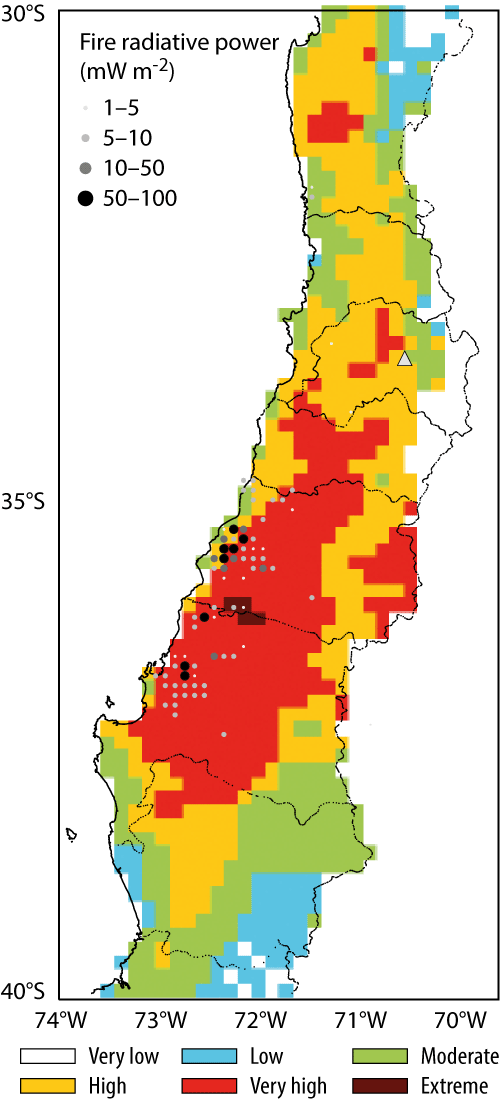Strong winds, high temperatures and long-term drought conditions led to some of the worst wildfires in Chile’s history during the last two weeks of January 2017. Fires in the central regions of O’Higgins, Maule and Bío Bío south of Santiago were widely reported by the global media. The Emergency Response Coordination Centre of the European Commission (ERCC) reported that between 1 July 2016 and 2 February 2017 approximately 3,000 fires had affected more than 575,000 hectares and 6,000 people.
ECMWF monitors global wildfire emissions and smoke transport and produces forecasts of fire danger under activities for the Copernicus Atmosphere Monitoring Service (CAMS) and the Copernicus Emergency Management Service (Copernicus EMS).
Data from the CAMS Global Fire Assimilation System (GFAS) provides information on the distribution of observed fire activity and indicates the relative intensity of each observed fire. The time series of daily CO2 fire emissions for Chile shown in the chart is used here to indicate the relative fire intensity. It highlights the unusual nature of the January activity. There were 13 consecutive days between 17 and 29 January in which the daily total emission far exceeded the climatological maximum over the years 2003–2016. The total emission of CO2for the whole of January was estimated to be more than 30 megatonnes, which is six times greater than typical January totals for Chile and accounted for approximately 8% of the January 2017 total global fire emissions. The smoke plumes from these fires extended for several hundred kilometres over the Pacific Ocean in global forecasts of atmospheric composition produced by CAMS.

Fire danger forecasts
The Global ECMWF Fire Forecast (GEFF) system provides daily forecasts of fire danger using the high-resolution and ensemble prediction system up to 10 days ahead. GEFF forecasts of fire danger represented by the Fire Weather Index (FWI) indicate the predicted fire intensity at the flame front if there were to be a fire. They correspond well to the observed fire activity in central Chile: the peak emissions between 17 and 29 January are reflected in forecasts initiated up to seven days earlier. Both the geographical distribution and the timing of the peak danger were well predicted in the FWI forecasts. The most intense observed fire emissions in January occurred in regions where the predicted fire danger was high (i.e. fire danger classes 'high' and above). This gives us some confidence in the performance of the GEFF system in representing fire danger in a non-European region.
CAMS is operated by ECMWF under a delegation agreement with the European Commission and provides near-real-time forecasts and analyses of atmospheric composition globally and for Europe. The GEFF system was developed under Copernicus EMS activities and is the global fire modelling component of the European Forest Fire Information System (EFFIS). Fire danger classes and indices have been calculated for Chile using 40 years of ERA-Interim data in the GEFF reanalysis.
Useful web links:
CAMS website: http://atmosphere.copernicus.eu/
Copernicus EMS website: http://emergency.copernicus.eu/
GFAS data: http://apps.ecmwf.int/datasets/data/cams-gfas/
GEFF-reanalysis data: http://apps.ecmwf.int/datasets/data/geff-reanalysis/

